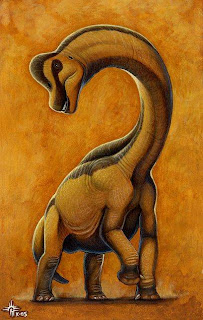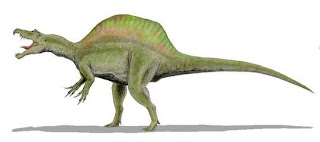1. Although paleontologists claim to have found bigger dinosaurs, Argentinosaurus is the biggest sauropod whose size has been backed up by convincing evidence. This gigantic plant-muncher (named after Argentina, where its remains were found) measured about 120 feet from head to tail and may have weighed over 100 tons. Just one vertebra of Argentinosaurus is over four feet thick! (Other, less-well-attested contenders for the “biggest sauropod” title include Futalognkosaurus, Bruhathkayosaurus and Amphicoelias.)
2. Named after Poseidon, the Greek god of the ocean, Sauroposeidon was once thought to be the biggest dinosaur of all time, but paleontologists have since concluded that it was slightly lighter than Argentinosaurus, “only” about 50 or 60 tons. However, Sauroposeidon was almost certainly the tallest sauropod ever to roam the earth; its neck alone was almost 40 feet long!
3. You probably thought the winner in this category would be T. Rex, but it’s now believed that Spinosaurus (which had a huge, crocodile-like mouth and a sail of skin jutting up from its back) was slightly heavier, weighing in at 7 or 8 tons. It’s possible that this dinosaur’s famous sail evolved as a way of increasing its skin area, and hence allowing it to cool down faster–yet more evidence that Spinosaurus was the king of the meat-eaters.
4. Just as Sauroposeidon is named after the Greek god of the ocean, Quetzalcoatlus is named after the winged Aztec god Quetzalcoatl. This gigantic pterosaur had a wingspan of up to 45 feet, making it the largest creature ever to fly, modern eagles included. That is, if Quetzalcoatlus really did fly: new research hints that this giant pterosaur may have led a completely landbound existence.
5. With its long, thick, tooth-studded jaws, bulky body, and massive flippers, this pliosaur looked a bit like a cross between an orca and a shark. Paleontologists believe Liopleurodon attained lengths of 40 to 50 feet, and may have weighed 20 to 30 tons, about the dimensions of an adult sperm whale. If this doesn’t sound impressive, keep in mind that the biggest great white sharks weigh about 3 tons, max.
6. The hadrosaurs, or duck-billed dinosaurs, were the most common herbivores of the late Cretaceous period. Recently discovered in China, Shantungosaurus was the biggest hadrosaur yet known, about 50 feet long and anywhere from 15 to 50 tons (the largest size ever achieved by an ornithischian, rather than saurischian, dinosaur). Amazingly, this giant duckbill may have been capable of running on two legs when escaping carnivores. (There’s speculation that a new Chinese hadrosaur, Zhuchengosaurus, may have been even bigger than Shantungosaurus!)
7. Velociraptor gets all the press these days, but this chicken-sized raptor was positively puny next to Utahraptor, which weighed in at a whopping 1,500 pounds (and was a full 20 feet long). Oddly, Utahraptor lived a few tens of millions of years before its more famous (and smaller) cousins, a reversal of the general evolutionary rule that tiny progenitors evolve into plus-sized descendants.
8. The therapsids (”mammal-like reptiles”) were a group of terrestrial reptiles that preceded the dinosaurs. The ungainly Moschops, which ruled the forests of Gondwana during the Permian period, looked a bit like a cross between a cow and a frog, with its blunt, bovine face and splay-footed, four-legged posture. This odd creature may have reached lengths of up to 20 feet and weights of a few tons, making it the biggest land animal of its time.
9. Better known as “SuperCroc,” the 40-foot-long Sarcosuchus weighed about 8 tons–about twice as long, and ten times as heavy, as the biggest crocodiles alive today. Despite its enormous size, though, Sarcosuchus appears to have led a typical crocodilian lifestyle, lurking in African rivers of the middle Cretaceous period and launching itself at any dinosaurs unlucky enough to draw too near.
10. The ichthyosaurs (”fish lizards”) were a group of sleek, hydrodynamic, and often quite large aquatic reptiles that thrived from the late Triassic to the middle Cretaceous periods. No ichthyosaur came bigger than the 50-foot-long, 30-ton Shonisaurus, which looked like a cross between a blue whale and a dolphin. Oddly enough, Shonisaurus is the official state fossil of land-locked Nevada, which was partially submerged in water in prehistoric times.
Source: http://scienceray.com/earth-sciences/paleontology/10-biggest-dinosaurs/ixzz1OOTZzUzL





























0 Comment: